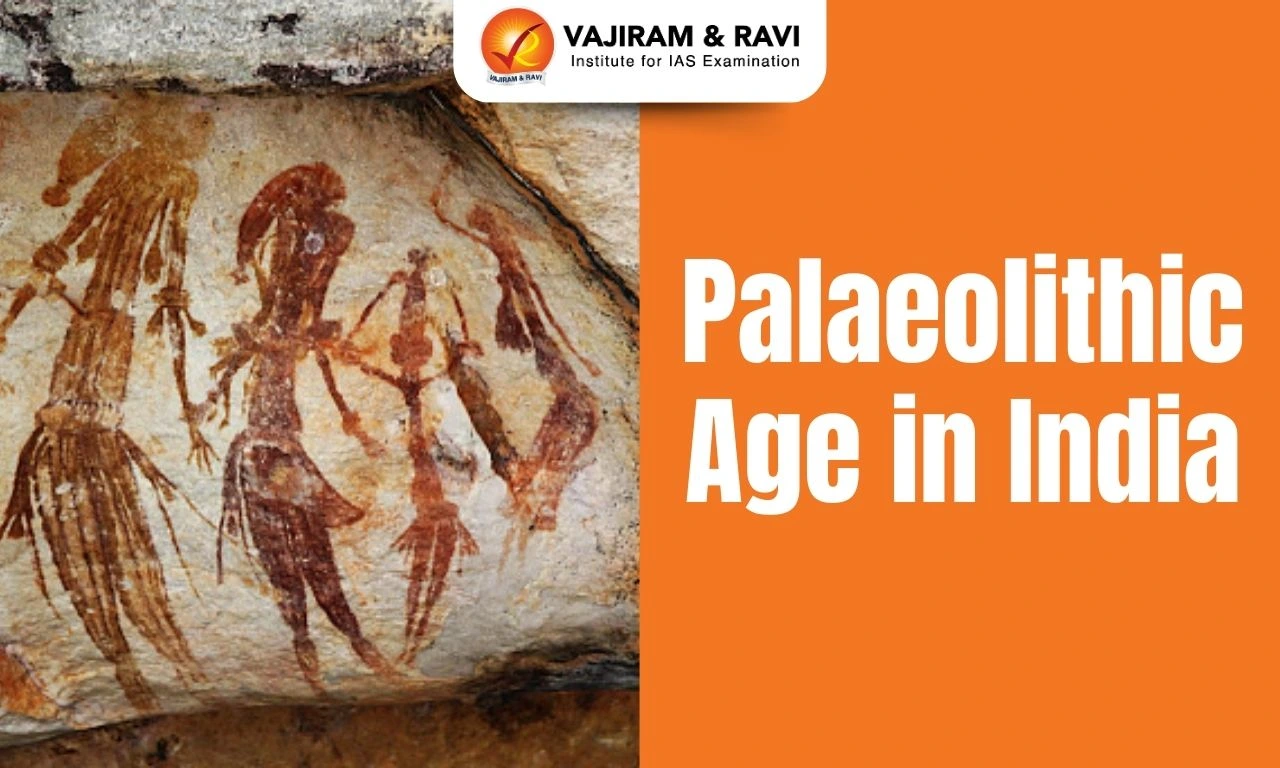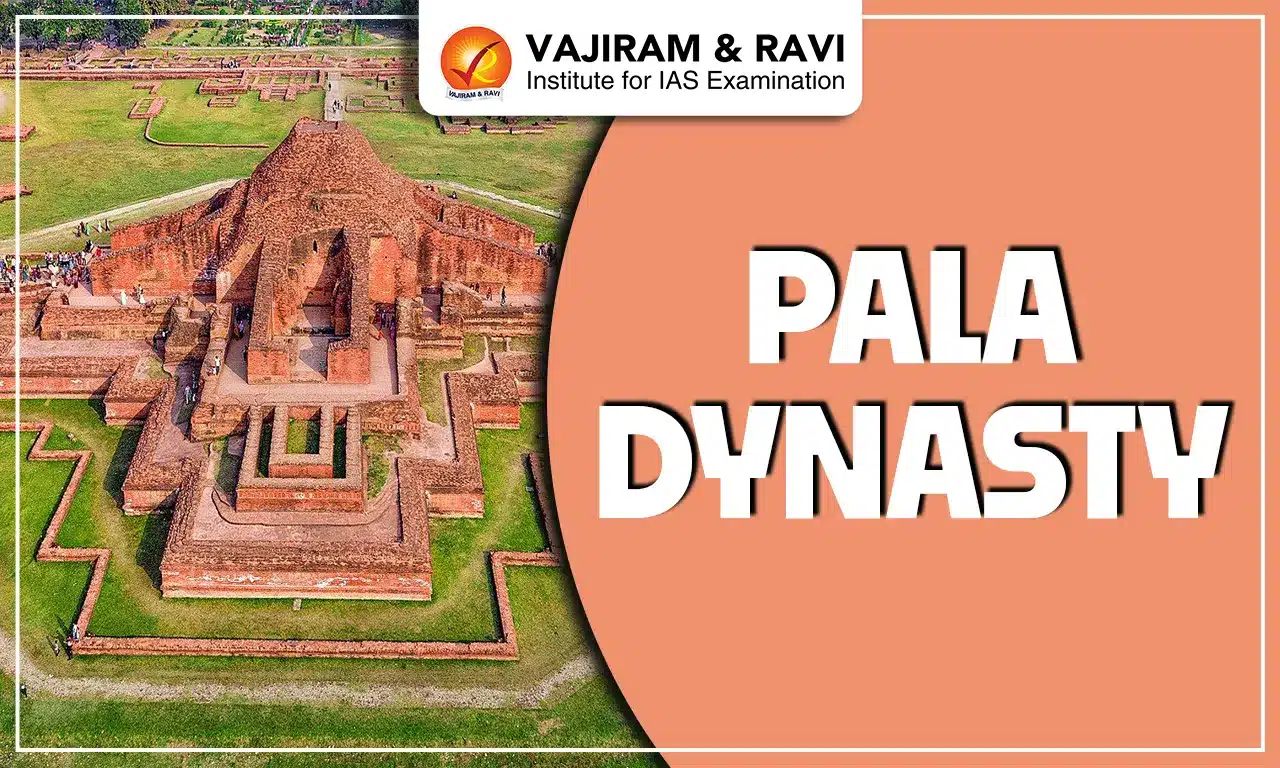The term "Palaeolithic" refers to the Old Stone Age of the Prehistoric Period because it derives from the Greek words palaeos, which means old, and lithos, which means stone. This time period belongs to the Pleistocene geological era. The use of stone tools appeared first in the Palaeolithic period. In India, no human fossils have been found in association with Stone Age tools. However, geological dating provides some insight into the antiquity of tools. When assessing the evidence for early human settlement in India, it is observed to be later than the African region but contemporaneous with other Asian countries.
Classification of Palaeolithic Age of Prehistoric Period
Depending on the technology of the tools used, economic activities, and other cultural features, the Palaeolithic age can be divided into the Lower Palaeolithic, Middle Palaeolithic, and Upper Palaeolithic.


Lower Palaeolithic Age in India (5,00,000- 1,00,000 BC)
The earliest use of stone was started in the Lower Palaeolithic Age by Homo habilis and Homo erectus. People of this age were nomadic and depended only on hunting and food gatherings.
- Tools: Stone tools were used for chopping, like hand axes, cleavers, knives, and choppers made from large pebbles or flakes.

- There are two main traditions:
- Soanian tradition, which is a part of the East and Southeast Asian chopper-chopping tool tradition.
- The Acheulian prehistoric period tradition, which is well-known from the western half of the Old World (Africa, western Europe, and West and South Asia), is represented by the handaxe-cleaver or biface assemblages.
- Way of life: The people from the Lower Palaeolithic culture hunted animals and collected roots, nuts, and fruits.
- They consumed the meat and bones of animals.
- They lived in open air, river valleys, caves, and rock shelters, as evident from Bhimbetka in Madhya Pradesh and Gudiyam in Tamil Nadu.
- The pre-historic human ancestors, who belonged to the species Homo erectus, did not have a complex language culture like us, the Homo sapiens.
- They may have expressed a few sounds or words and used sign language.
- They were intelligent enough to select stones as raw material and used hammer stones to carefully flake the rocks and design tools.
- Important Sites:
- Singi Talav (Didvana) in Rajasthan
- Bhimbetka and Adamgarh in Madhya Pradesh
- Lalitpur, Uttar Pradesh
- Paisra, Bihar
- Chirki-Nevasa, Maharashtra
- Hunsgi and Yediyapur in Karnataka
- Attirampakkam, Tamil Nadu
Middle Palaeolithic Age in India (1,00,000- 40,000 BC)
Middle Palaeolithic culture in India is called Nevasian (similar to Mousterian), as flake tools were found at Pravara, Nevasa. Early Homo sapiens lived in the Middle Paleolithic Age, marked by the evolution of modern language, the systematic burial of the dead with rituals, and the use of more sophisticated tools. This age witnessed a variety of tools made on flakes, produced by specialised techniques. Therefore, it is widely referred to as the flake tool industry.
- Tools:
- Flake Production: Flakes that are produced by striking them out of pebbles or cobbles are used to make tools.
- Tool Types: Small and medium-sized handaxes, cleavers, scrapers, borers, and knives are examples of different types of tools. Raw materials, shapes, and sizes vary depending on the region.
- Large Borers and Awls: Large borers or awls worked with steep retouch on thick flakes are present.
- Variety of Scrapers: Scrapers come in several kinds, such as straight, concave, and convex-sided.
- Anvils and Hammers are also found at some of the manufacturing sites.
- Way of life: The Middle Palaeolithic people lived in rock shelters, caverns, and open spaces. It was a hunter-gatherer society. The following are some of the primary characteristics of the Indian Middle Palaeolithic period:
- The tools became smaller.
- There was a decrease in the use of hand axes compared to other tools.
- The core preparation techniques were used in the stone tool production.
- The raw materials used were chert, jasper, chalcedony, and quartz.
- Sites:
- Didwana and Budha Pushkar are in Rajasthan
- Hiran Valley in Gujarat
- Potwar Plateau situated between the Indus and Jhelum rivers
- Sanghao Cave in NWFP of Pakistan
- Luni river system, denoting tool industries west of the Aravallis
- Chirki Nevasa in Maharashtra
- Kalpi in Uttar Pradesh
Upper Palaeolithic Age in India (40,000-10,000 BC)
This is the phase when modern man (Homo sapiens sapiens) first emerged around 50,000 years ago and developed new tool-making technologies in the form of blades and burins.
- Upper Palaeolithic cultures flourished in the Upper Pleistocene, often called the Late Pleistocene.
- Along with flake and core tools, the Upper Palaeolithic industries produced side scrapers, ovate scrapers, notched scrapers, discoid scrapers, and unifacial and bifacial flake points.
- This is the period when humans were involved in cave art.
- Tools:
- The sites in Rallakalava and Gunjuna valleys in the southern Eastern Ghats give the best-known evidence of the blade-and-burin industries in India.
- Bone tools, except in Kurnool caves in Andhra Pradesh, were not found in India.
- The manufacture of specialised hunting tools for both big-game hunting and small-game hunting, as well as fishing, is indicated by the Upper Palaeolithic tools.

- Way of life: The people who lived during this time utilised both open spaces and caves for housing.
- Paintings from the Upper Palaeolithic era provide evidence of artistic creations.
- This era's beads and decorations have also been discovered.
- During this time, the lithic blade industry developed.
- Based on style and archaeological evidence, some of the green-colored paintings by Bhimbetka are dated to the Upper Palaeolithic period.
- Sites:
- Rohiri Hills in Sindh
- Chopani Mando in Belan Valley
- Baghor in Madhya Pradesh
- Paisra in Bihar
- Haora and Khowai valleys in Tripura
- Kurnool and Muchchatla Chintamanu Gavi in Andhra Pradesh
Last updated on December, 2025
→ Check out the latest UPSC Syllabus 2026 here.
→ Join Vajiram & Ravi’s Interview Guidance Programme for expert help to crack your final UPSC stage.
→ UPSC Mains Result 2025 is now out.
→ UPSC Notification 2026 is scheduled to be released on January 14, 2026.
→ UPSC Calendar 2026 is released on 15th May, 2025.
→ The UPSC Vacancy 2025 were released 1129, out of which 979 were for UPSC CSE and remaining 150 are for UPSC IFoS.
→ UPSC Prelims 2026 will be conducted on 24th May, 2026 & UPSC Mains 2026 will be conducted on 21st August 2026.
→ The UPSC Selection Process is of 3 stages-Prelims, Mains and Interview.
→ UPSC Result 2024 is released with latest UPSC Marksheet 2024. Check Now!
→ UPSC Prelims Result 2025 is out now for the CSE held on 25 May 2025.
→ UPSC Toppers List 2024 is released now. Shakti Dubey is UPSC AIR 1 2024 Topper.
→ UPSC Prelims Question Paper 2025 and Unofficial Prelims Answer Key 2025 are available now.
→ UPSC Mains Question Paper 2025 is out for Essay, GS 1, 2, 3 & GS 4.
→ UPSC Mains Indian Language Question Paper 2025 is now out.
→ UPSC Mains Optional Question Paper 2025 is now out.
→ Also check Best IAS Coaching in Delhi
Palaeolithic Age FAQs
Q1. What is the Palaeolithic age?+
Q2. What are the types of Palaeolithic Age?+
Q3. Which tools were used in the middle Palaeolithic age of India?+
Q4. What terms are used for humans from the Palaeolithic Period?+
Q5. What is another name for the Palaeolithic Age?+

















